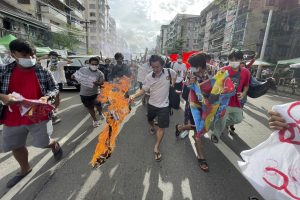The Myanmar military’s seizure of power in February tipped the country into turmoil.
Almost immediately, mass protests erupted and tens of thousands went on strike to oppose the new military junta led by Senior General Ming Aung Hlaing. Seven months on, the demonstrations have largely dissipated under the violent repression of the security forces, but armed resistance – in both urban and rural areas – has taken their place, holding out the prospect of a grinding political stalemate. Meanwhile, COVID-19 has surged into the vacuum of state capacity left by the coup, threatening to compound a generational political crisis with a public health emergency.
Richard Horsey, an independent political analyst and long-time adviser for the International Crisis Group, speaks with The Diplomat about the evolution of the popular resistance to the junta, how foreign governments can help alleviate the COVID-19 crisis, and whether the current tumult might give rise to a new and more inclusive political paradigm in Myanmar.
In the seven months since the Tatmadaw’s seizure of power, how have the tactics of the anti-coup resistance evolved? What does this suggest to you about the future trajectory of the crisis?
The anti-coup resistance is diverse and determined. In the early days after the coup, their demand was the release of State Counsellor Aung San Suu Kyi and President Win Myint and a return to status quo ante. As the regime’s crackdown became increasingly violent, both the demands and the tactics of the resistance shifted. A return to the situation before the coup was no longer acceptable and the objective became the ouster of the regime, the replacement of the military with a new institution under civilian control, and the abrogation of the 2008 Constitution and its replacement with a more democratic and federal charter.
In terms of tactics, it quickly became clear that the regime would not back down in the face of mass street protests, and as the security forces began violent attacks and killings of demonstrators and communities, forms of violent resistance emerged. These include ambushes and attacks on military and police targets in rural areas, and assassinations and bombings in urban areas. The situation is becoming increasingly violent, including tit-for-tat killings within communities by resistance forces and conservative forces, both plainclothes members of the security forces and other anti-resistance community members, the so-called Pyusawhti.
There is a history of violent resistance in Myanmar, for example after the 1988 crackdown on demonstrations and the subsequent formation of a Student Army. But the mainstream opposition under Aung San Suu Kyi adopted an explicitly non-violent and political approach. The embrace of violent tactics by the resistance movement represents a decisive shift away from Aung San Suu Kyi’s approach, mainly because peaceful responses were seen as untenable given the level of violence unleashed by the regime.

































